1995 BUICK REGAL ESP
[x] Cancel search: ESPPage 6 of 340
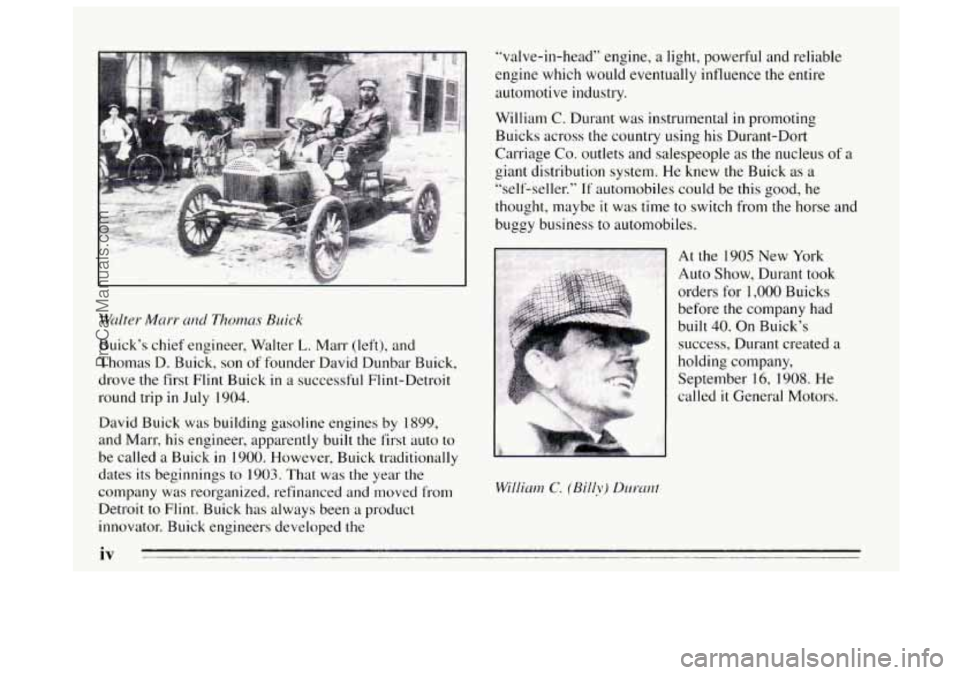
Walter Murr and Thomas Buick
Buick’s chief engineer, Walter L. Marr (left), and
Thomas
D. Buick, son of founder David Dunbar Buick,
drove the first Flint Buick
in a successful Flint-Detroit
round trip in July 1904.
David Buick was building gasoline engines by
1899,
and Marr, his engineer, apparently built the first auto to
be called a Buick in 1900. However, Buick traditionally
dates its beginnings
to 1903. That was the year the
company
was reorganized, refinanced and moved from
Detroit to
Flint. Buick has always been a product
innovator. Buick engineers developed the “valve-in-head”
engine,
a light, powerful and reliable
engine which would eventually influence the entire
automotive industry.
William
C. Durant was instrumental in promoting
Buicks across the country using his Durant-Dort
C‘miage Co. outlets and salespeople
as the nucleus of a
giant distribution system. He knew the Buick as a
“self-seller.” If automobiles could be this good, he
thought, maybe
it was time to switch from the horse and
buggy business to automobiles.
At the 1905 New York
Auto Show, Durant took
orders
for 1,000 Buicks
before
the company had
built
40. On Buick’s
success, Durant created
a
holding company,
September
16, 1908. He
called
it General Motors.
ProCarManuals.com
Page 22 of 340
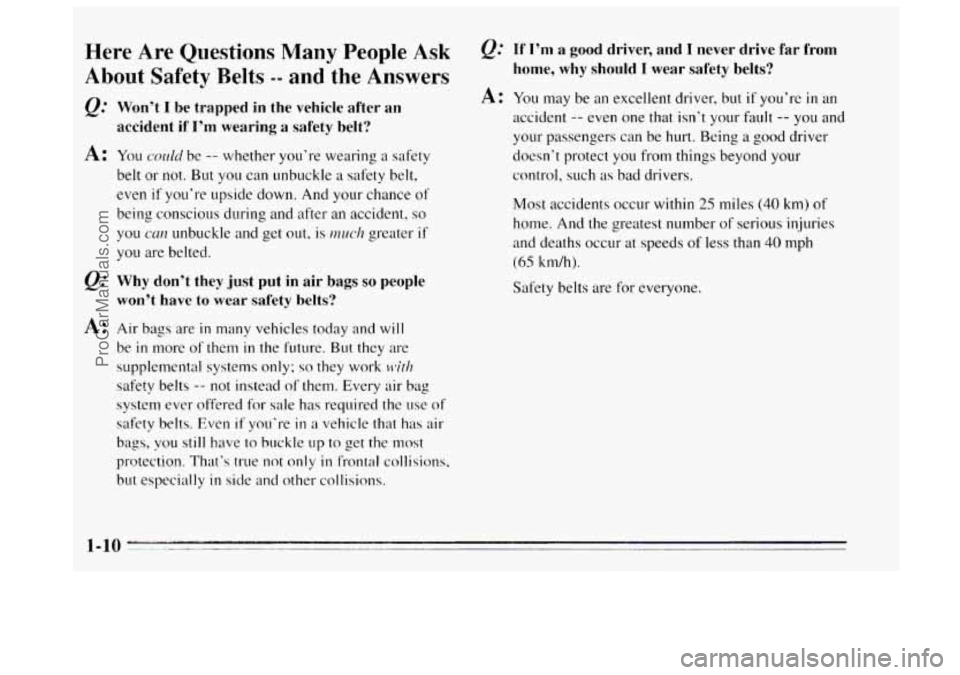
Here Are Questions Many People Ask
About Safety Belts -- and the Answers
Q.’ Won’t I be trapped in the vehicle after an
accident if
I’m wearing a safety belt?
A: YOLI cndd be -- whether you’re wearing a safety
belt or not,
But you can lmbuckle a safety belt,
even
if you‘re upside down. And your chance of
being conscious during and after an accident, so
you can unbuckle and get out, is 1n~tc17 greater if
you are belted.
Why don’t they just put in air bags so people
won’t have
to wear safety belts?
A: Air bags are in many vehicles today and will
be in Inore of them in the future. But they are
supplemental systems only;
so they work ~Yth
safety belts -- not instead of them. Every air bag
system ever offered for sale has required the use
of
safety belts. Even if you’re in a vehicle that has air
bags, you still have to buckle up to get the most
protection. That‘s true
not only in frontal collisions,
but. especially
in side and other collisions.
Q.’ If I’m a good driver, and I never drive far from
home, why should
I wear safety belts?
A: You may be an excellent driver, but if you’re in an
accident
-- even one that isn’t your fault -- you and
your passengers can be hurt. Being a good driver
doesn’t protect you from things beyond your
control, such as bad drivers.
Most accidents occur within
25 miles (40 km) of
home. And the greatest number of serious injuries
and deaths occur at speeds
of less than 40 mph
(65 km/h).
Safety belts are for everyone.
ProCarManuals.com
Page 70 of 340
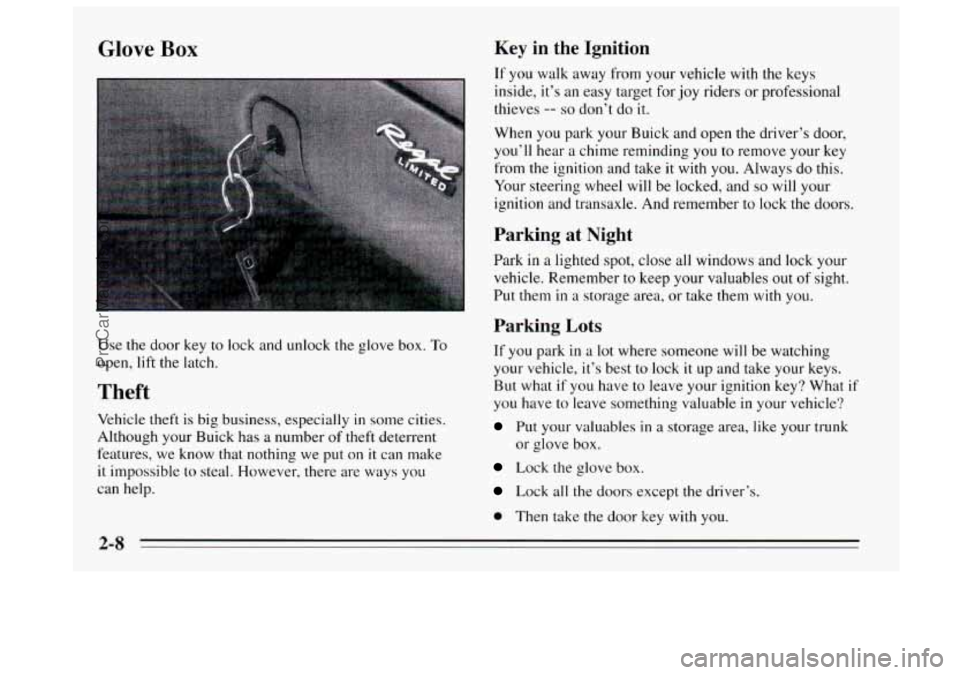
Glove Box Key in the Ignition
If you walk away from your vehicle with the keys
inside, it’s an easy target for joy riders or professional
thieves
-- so don’t do it.
When you park your Buick and open the driver’s door,
you’ll hear a chime reminding you to remove your key
from the ignition and take it with
you. Always do this.
Your steering wheel will be locked, and
so will your
ignition and transaxle. And remember to lock the doors.
Parking at Night
Park in a lighted spot, close all windows and lock your
vehicle. Remember to keep your valuables out of sight.
Put them in
a storage area, or take them with you.
Parking Lots
Use the door key to lock and unlock the glove box. To
open, lift the latch.
Theft
Vehicle theft is big business, especially in some cities.
Although your Buick has
a number of theft deterrent
features, we know that nothing we put on
it can make
it impossible to steal. However, there are ways you
can help.
If you park in a lot where someone will be watching
your vehicle, it’s best to lock it
up and take your keys.
But what if
you have to leave your ignition key? What if
you have to leave something valuable in your vehicle?
Put your valuables in a storage area, like your trunk
or glove box.
Lock the glove box.
Lock all the doors except the driver’s.
0 Then take the door key with you.
2-8
ProCarManuals.com
Page 94 of 340
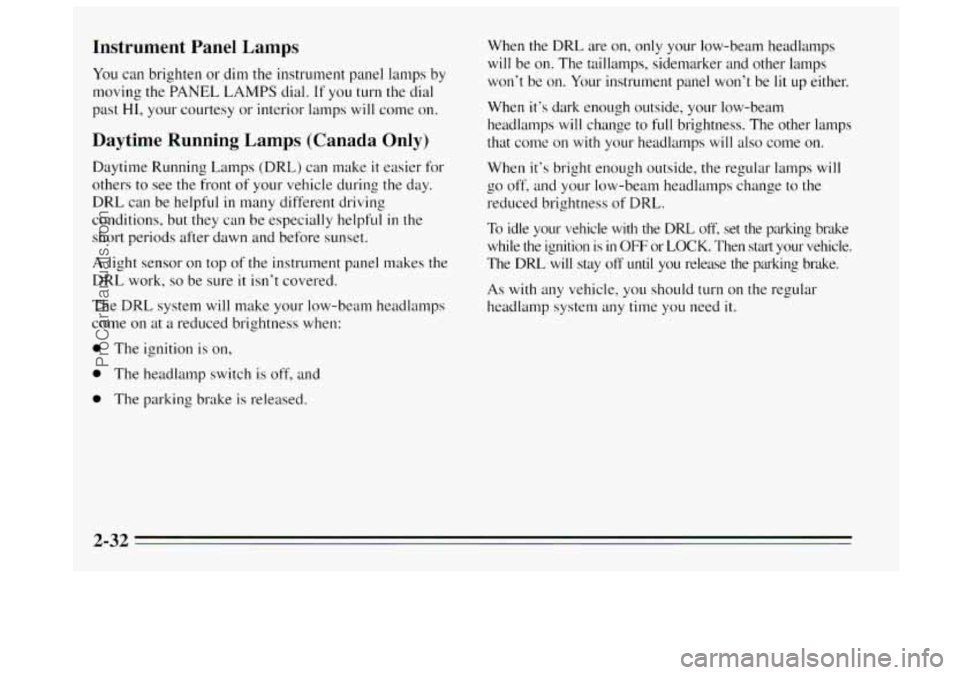
Instrument Panel Lamps
You can brighten or dim the instrument panel lamps by
moving the PANEL
LAMPS dial. If you turn the dial
past
HI, your courtesy or interior lamps will conle on.
Daytime Running Lamps (Canada Only)
Daytime Running Lamps (DRL) can make it easier for
others to see the front of your vehicle during the day.
DRL can be helpful in many different driving
conditions, but they can be especially helpful
in the
short periods after dawn and before sunset.
A light sensor on top of the instrument panel makes the
DRL work,
so be sure it isn’t covered,
The
DRL system will make your low-beam headlamps
come on at a reduced brightness when: When the DRL
are
on, only your low-bearn headlamps
will be on. The taillamps, sidemarker and other lamps
won‘t be
on. Your instrument panel won’t be lit up either.
When it’s dark enough outside, your low-beam
headlamps will change to
full brightness. The other lamps
that come
on with your headlamps will also come on.
When it’s bright enough outside, the regular lamps
will
go off, and your low-beam headlamps change to the
reduced brightness of DRL.
To idle your vehicle with the DRL off, set the parking brake
while the ignition is
in OFF or LOCK. Then start your vehicle.
The
DIU will stay off until you release the parking brake.
As with any vehicle, you should turn on the regular
headlamp system any time you need it.
0 The ignition is on,
0 The headlamp switch is off, and
0 The parking brake is released.
2-32
ProCarManuals.com
Page 133 of 340
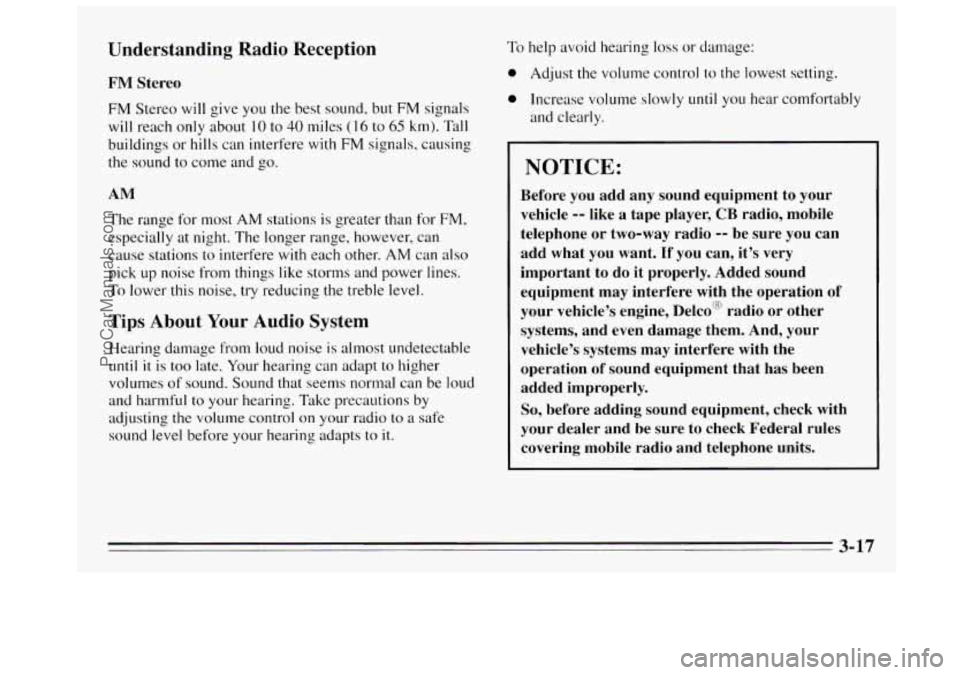
Understanding Radio Reception
FM Stereo FM Stereo will give you the best sound, but FM signals
will reach only about
10 to 40 miles ( 16 to 65 km). Tall
buildings or hills can interfere with FM signals, causing
the sound to come and go.
AM
The range for most
AM stations is greater than for FM.
especially at night. The longer range, however, can
cause stations
to interfere with each other. AM can also
pick up noise from things like storms and power lines.
To lower this noise, try reducing the treble level.
Tips About Your Audio System
Hearing damage from loud noise is almost undetectable
unt.il it is too late. Your hearing can adapt to higher
volumes
of sound. Sound that seems normal can be loud
and harmful to your hearing. Take precautions by
adjusting the volume control on your radio to a safe
sound level before your hearing adapts to it.
To help avoid hearing loss or damage:
0 Adjust the volume control to the lowest setting.
0 Increase volume slowly until you hear cornfortably
and clearly.
NOTICE:
Before you add any sound equipment to your
vehicle
-- like a tape player, CB radio, mobile
telephone or two-way radio
-- be sure you can
add what you want.
If you can, it's very
important to do it properly. Added sound
equipment may interfere with the operation
of
your vehicle's engine, Delco" radio or other
systems, and even damage them. And, your
vehicle's systems may interfere with the
operation
of sound equipment that has been
added improperly.
So, before adding sound equipment, check with
your dealer and be sure
to check Federal rules
covering mobile radio and telephone units.
3-17
ProCarManuals.com
Page 142 of 340
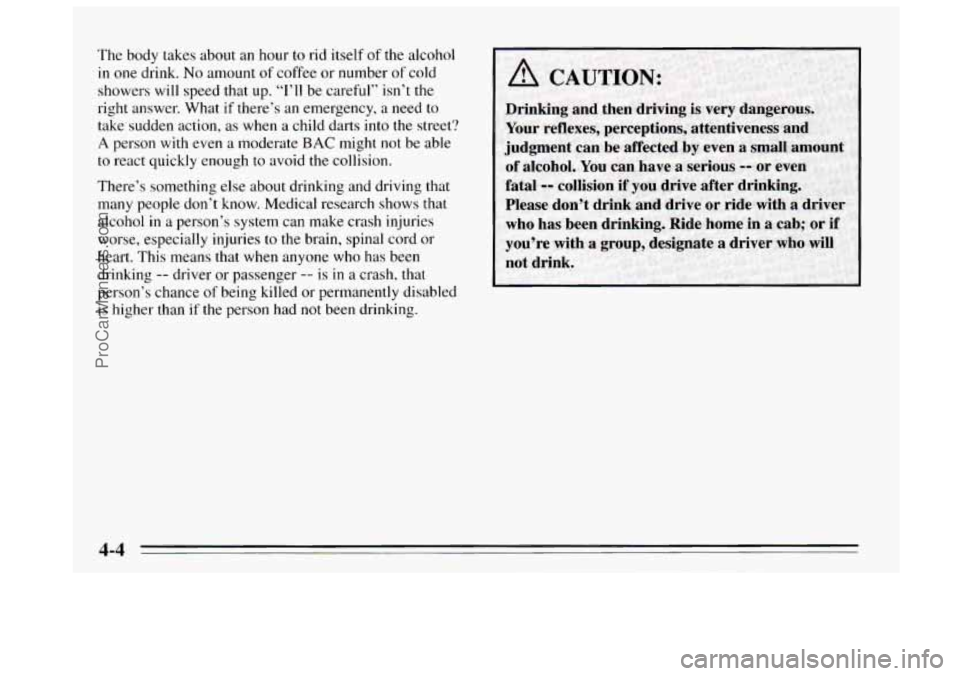
The body takes about an hour to rid itself of the alcohol
in one drink. No amount of coffee or number of cold
showers will speed that up. “I’ll be careful” isn’t
the
right answer. What if there’s an emergency, a need to
take sudden action, as when a child darts into the street?
A person with even a moderate BAC might not be able
to react quickly enough to avoid the collision.
There’s something else about drinking and driving that
many people don’t know. Medical research shows that
alcohol
in a person’s system can make crash injuries
worse, especially injuries
to the brain, spinal cord or
heart. This means that when anyone who has been
drinking
-- driver or passenger -- is in a crash, that
person’s chance
of being killed or permanently disabled
is higher than
if the person had not been drinking.
4-4
ProCarManuals.com
Page 149 of 340
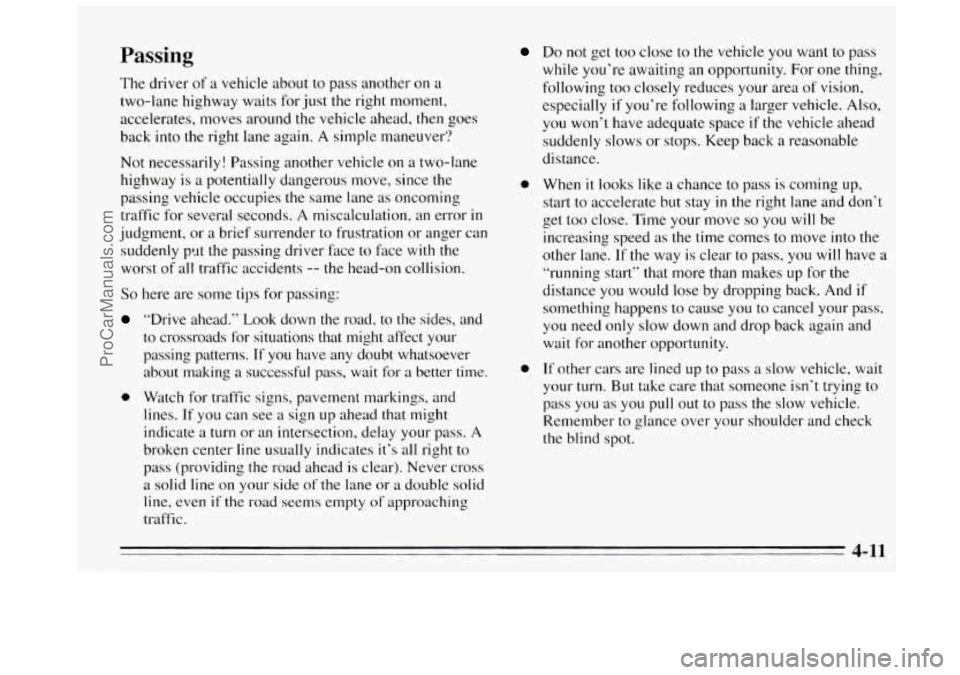
Passing
The driver of a vehicle about to pass another on a
two-lane highway waits for just the right moment,
accelerates, moves around the vehicle ahead, then goes
back into the right lane again.
A simple maneuver?
Not necessarily! Passing another vehicle on
a two-lane
highway is
a potentially dangerous move, since the
passing vehicle occupies the same lane as oncoming
traffic for several seconds. A miscalculation, an error
in
judgment, or a brief surrender to frustration or anger can
suddenly pst
the passing driver face to face with the
worst of
all traffic accidents -- the head-on collision.
So here are some tips for passing:
“Drive ahead.” Look down the road, to the sides, and
to crossroads for situations that might affect your
passing patterns.
If you have any doubt whatsoever
about making
a successful pass, wait for a better time.
0 Watch for traffic signs, pavernent markings, and
lines. If you can see
a sign up ahead that might
indicate
a turn or an intersection, delay your pass. A
broken center line usually indicates it’s all right to
pass (providing the road ahead is clear). Never cross
a solid line on your side of the lane or a double solid
line, even if
the road seems empty of approaching
traffic.
Do not get too close to the vehicle you want to pass
while you’re awaiting an opportunity. For one thing,
following
too closely reduces your area of vision,
especially
if you’re following a larger vehicle. Also,
you won’t have adequate space if the vehicle ahead
suddenly slows
or stops. Keep back a reasonable
distance.
0 When it looks like a chance to pass is coming up,
start
to accelerate but stay in the right lane and don’t
get too close.
Time your move so you will be
increasing speed
as the time comes to move into the
other lane. If the way
is clear to pass, you will have a
“running start” that more than makes up for the
distance you would lose by dropping back. And
if
something happens to cause you to cancel your pass,
you need only
slow down and drop back again and
wait for another opportunity.
0 If other cars are lined up to pass a slow vehicle, wait
your turn. But take care that someone isn’t trying
to
pass you as you pull out to pass the slow vehicle.
Remember to glance over your shoulder and check
the blind spot.
4-11
ProCarManuals.com
Page 150 of 340
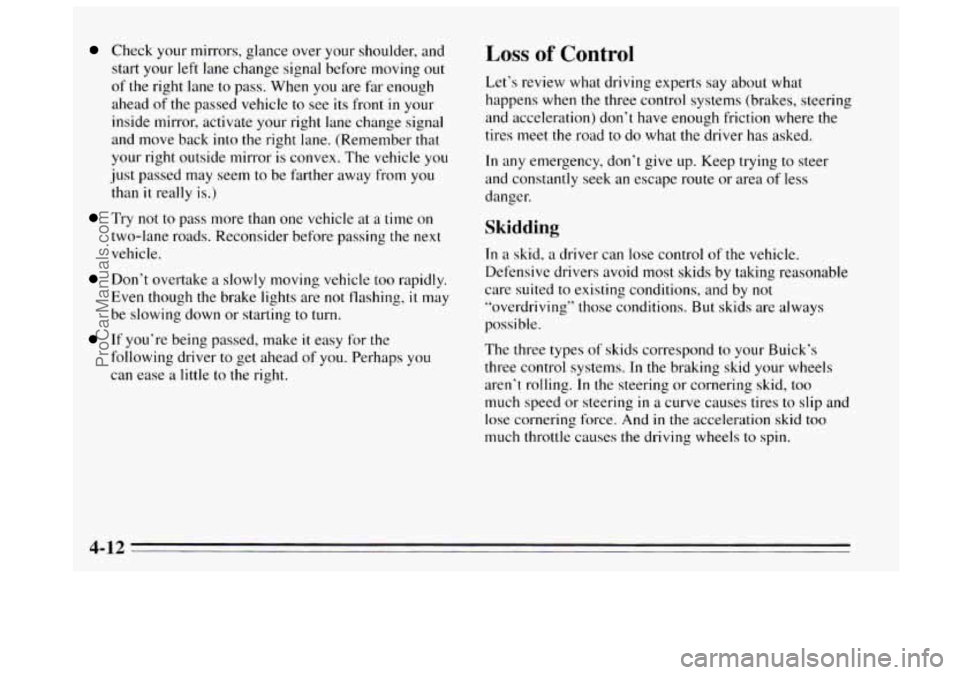
Check your mirrors, glance over your shoulder, and
start your left lane change signal before moving out
of the right lane to pass. When you are far enough
ahead
of the passed vehicle to see its front in your
inside mirror, activate your right lane change signal
and move back
into the right lane. (Remember that
your right outside mirror is convex. The vehicle you
just passed may seem
to be farther away from you
than it really is.)
Try not to pass more than one vehicle at a time on
two-lane roads. Reconsider before passing the next
vehicle.
Don’t overtake a slowly moving vehicle too rapidly.
Even though the brake lights are
not flashing, it may
be slowing down or starting to turn.
If you’re being passed, make it easy for the
following driver
to get ahead of you. Perhaps you
can ease
a little to the right.
Loss of Control
Let’s review what driving experts say about what
happens when the three control systems (brakes, steering
and acceleration) don’t have enough friction where the
tires meet the road
to do what the driver has asked.
In any emergency, don’t give up. Keep trying to steer
and constantly seek an escape route or area
of less
danger.
Skidding
In a skid, a driver can lose control of the vehicle.
Defensive drivers avoid most skids by taking reasonable
care suited to existing conditions, and by not
“overdriving” those conditions.
But skids are always
possible.
The three
types of skids correspond to your Buick’s
three control systems. In the braking skid your wheels
aren’t rolling. In the steering or cornering skid,
too
much speed or steering in a curve causes tires to slip and
lose cornering force. And
in the acceleration skid too
much throttle causes the driving wheels to spin.
4-12
ProCarManuals.com